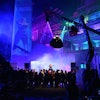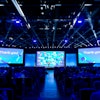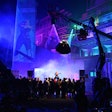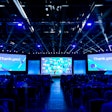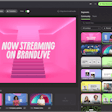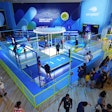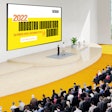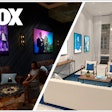
MIAMI—Art Basel in Miami Beach typically serves as the grand finale to a year’s worth of art world events, acting as the center upon which the larger Miami Art Week revolves. But, as expected, this year’s tentpole art fair was canceled due to the COVID-19 pandemic.
A scaled-down Miami Art Week still took place though, from Nov. 30 through Dec. 6—minus much of the razzle-dazzle. Vacant retail stores were converted into makeshift galleries for those collectors who were willing to shop in person and at their own risk. But gone were the lavish parties and brand activations that many come to Miami to experience. Instead, following years of record-breaking attendance, the event went back to its roots in a sense—focusing more on the art and less on the fun.
Usually, art collectors, buyers, and enthusiasts are able to browse works on display at the Miami Beach Convention Center, but for 2020, Art Basel organizers went digital, creating “OVR: Miami Beach,” which ran from Dec. 4-6. This virtual platform allowed attendees to peruse presentations from a lineup of 255 galleries from 30 countries and territories across North and South America, as well as Europe, Asia, and Africa.
 "We Are Having The Time of Our Lives" by SUPERFLEX was on display inside the Kukje Gallery online viewing room.Photo: Courtesy of Art Basel
"We Are Having The Time of Our Lives" by SUPERFLEX was on display inside the Kukje Gallery online viewing room.Photo: Courtesy of Art Basel
“Throughout the year, our galleries have honed creative and thoughtful ways to translate their fair presentations into a digital format, and collectors and patrons have responded to OVR: Miami Beach with an unmatched level of interest and enthusiasm. The energy of this online event underscores the importance of Miami Art Week within the art world calendar,” said Noah Horowitz, director Americas, Art Basel, in a statement.
Although buying art online remains a foreign concept to some collectors, this year’s Art Basel attendees seemed to embrace the digital experience, demonstrating that the event still holds influence despite the lack of fanfare and crowds.
“Although nothing replaces standing in front of a work with someone, we were on the phone with clients while they viewed the online viewing room,” explained Jessica Silverman, founder of the Jessica Silverman Gallery in San Francisco. “It's an indicator of the power of the Art Basel brand that, even during a pandemic, the fair creates momentum and festive seasonality, so our business can end the year on a high note.”
Monique Meloche, founder and owner of moniquemeloche in Chicago, echoed that sentiment, saying that “I feel that collectors are getting the hang of visiting virtually and come prepared as they would IRL. The VIP preview day had the energy of what a real fair feels like.”
And as we’ve seen with other virtual events, this digital version of Art Basel did have some benefits, such as allowing galleries to show more works to a larger audience for less money. “The advantage of the virtual fair is obviously the reduced cost of a booth, and all the expenses otherwise involved with an in-person fair like shipping, travel, and entertainment don’t apply,” Meloche said.
 Art Basel virtual attendees could browse works inside Hauser & Wirth's viewing room.Photo: Courtesy for Art Basel
Art Basel virtual attendees could browse works inside Hauser & Wirth's viewing room.Photo: Courtesy for Art Basel
Along with showcasing the works in its New York space (which were viewable by appointment), the AR tool allowed folks to virtually place works including Rita Ackermann’s “Mama, Bon Jour Monsieur Bernard,” Ed Clark’s “Untitled,” Philip Guston's “Untitled,” and Matthew Day Jackson’s “Ghost Bouquet V” in their own homes “to get a sense of how the art exists in context,” Payot said. Using their mobile devices, users can point their phone’s camera towards the area where they want to see the work and “place” it in their homes.
While the future of events in 2021 remains somewhat unclear, Art Basel organizers, as well as the galleries, are expecting to carry over the virtual elements of this year’s art fair. “While there simply is no substitute for experiencing art in person, I absolutely feel that digital is here to stay,” Payot said. “We are embracing it wholeheartedly at the gallery and experimenting with increasingly interesting ways to maximize its potential as a way to complement real-life experiences.”
